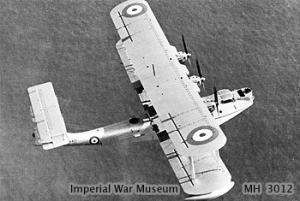Blackburn Perth
| R.B.3A Perth | |
|---|---|
 | |
| A Perth, flying with the MAEE in 1935 | |
| Role | Flying boat |
| Manufacturer | Blackburn Aeroplane and Motor Company |
| Designer | John Douglas Rennie |
| First flight | 11 October 1933 |
| Introduction | 1934 |
| Retired | 1938 |
| Primary user | Royal Air Force |
| Produced | 1933-1934 |
| Number built | 4 |
| Developed from | Blackburn Iris |
The Blackburn Perth was a British flying boat in service during the interwar period. It was essentially an upgraded Iris, hence the largest flying-boat to serve with the Royal Air Force at the time (and the largest biplane flying boat ever to serve with the RAF).
Design and development
The Blackburn R.B.3A Perth was designed as a replacement for the earlier Iris to Air Ministry Specification 20/32. Developed from the Iris Mk. V, the Perth first flew in 1933.[1] It differed from the Iris by replacing the Rolls-Royce Condor engines of the Iris by more powerful Rolls-Royce Buzzards and having an enclosed cockpit for the pilots. Unusually, in addition to its normal armament, the Perth was fitted with a Coventry Ordnance Works C.O.W 37 mm (1.46 in) autocannon in its bows.[2]
Four Perths were ordered for service for the RAF.[3]
Operational history
The Perth entered service with the RAF in January 1934,[3] when the second aircraft was delivered to No. 209 Squadron RAF at RAF Mount Batten Plymouth.[1] Perths remained in service until 1937,[1] being replaced by the Short Singapore and the Saro London. One aircraft was retained by the Marine Aircraft Experimental Establishment until 1938.
Operators
Specifications (Perth)
Data from Aircraft of the Royal Air Force 1918-57 [1]
General characteristics
- Crew: five
- Length: 70 ft 0 in (21.34 m)
- Wingspan: 97 ft 0 in (29.57m)
- Height: 26 ft 5 1⁄2 in (8.06 m)
- Wing area: 2,461 ft2 (233.3 m2)
- Empty weight: 20,927 lb (9,492 kg)
- Loaded weight: 32,500 lb (14,772 kg)
- Max. takeoff weight: 38,000 lb [3] (17,237 kg)
- Powerplant: 3 × Rolls-Royce Buzzard II MS 12-cylinder water-cooled inline engine, 825 hp (615 kW) each
Performance
- Maximum speed: 115 kn (132 mph, 213 km/h)
- Cruise speed: 95 kn [3] (109 mph, 175 km/h)
- Range: 1,130 nmi (1,300 mi, 2,093 km)
- Service ceiling: 11,500 ft (3,500 m)
- Rate of climb: 800 ft/min (4.1 m/s)
- Wing loading: 13.2 lb/ft2 (63.3 kg/m2)
- Power/mass: 0.076 hp/lb (0.12 kW/kg)
Armament
- 1 × C.O.W 37 mm (1.46 in) automatic cannon in bow
- 3 × .303 in (7.7 mm) Lewis guns in bow, amidships and tail positions
- Up to 2,000 lb bombs
See also
- Related development
- Aircraft of comparable role, configuration and era
References
- 1 2 3 4 Thetford, Owen (1957). Aircraft of the Royal Air Force 1918-57 (1st ed.). London: Putnam. pp. 76–77.
- ↑ "C.O.W. 37mm cannon fitted to Blackburn Perth flying boat", YouTube
- 1 2 3 4 Donald, David (Editor) (1997). The Encyclopedia of World Aircraft. Aerospace Publishing. p. 134. ISBN 1-85605-375-X.
External links
| Wikimedia Commons has media related to Blackburn Perth. |
- British Blackburn-General Flying Boats
- "New Plane Hunts Submarines" Popular Science, January 1934
- "Huge All Metal Flying Boat Weighs Ten Tons" Popular Mechanics, March 1931